Services on Demand
Journal
Article
Indicators
-
 Cited by SciELO
Cited by SciELO -
 Access statistics
Access statistics
Related links
-
 Similars in
SciELO
Similars in
SciELO
Share
Revista Latinoamericana de Desarrollo Económico
On-line version ISSN 2074-4706
rlde no.23 La Paz May 2015
CIENTIFIC ARTICLE
Institutional Changes and Cyclical Transition in the Fiscal Stance for Bolivia (2003-2011)
Cambios institucionales y transición cíclica en la posición fiscal para Bolivia (2003-2011)
Roger Alejandro Banegas Rivero*, Reyna González Vergara **
Abstract
In this paper the efficiency of fiscal role was evaluated in relation to institutional changes resulting from nationalization of hydrocarbons and cyclical transition changes in the fiscal stance for the Bolivian case, based on quarterly information: 2003-2011. The degree of sustainable fiscal stance (with and without oil) was a conclusive element to determine the efficiency of fiscal role, and in this case, a deficient result for the Bolivian case was founded by using filters for economic time series, cyclically adjusted fiscal balance (CAB) and the indicator of fiscal sustainability (IFS) developed by Croce and Hugo (2003).
Keywords: Efficiency of fiscal role, institutional changes, cyclical transition, sustainable fiscal stance.
Resumen
En este documento se evaluó la eficiencia del rol fiscal relacionado con cambios institucionales derivados de la nacionalización de los hidrocarburos y la transición de los cambios cíclicos en la posición fiscal de Bolivia, con base en información trimestral: 2003-2011. El grado de posición fiscal sostenible (con y sin petróleo) fue un elemento concluyente para determinar la eficiencia del rol fiscal, cuyo resultado fue deficiente para el caso de Bolivia. Se emplearon filtros para series económicas, la metodología de balance fiscal cíclicamente ajustado (BCA) y el indicador de posición fiscal sostenible (PFS) de Croce y Hugo (2003).
Palabras claves: Eficiencia del rol fiscal, cambios institucionales, transición cíclica, posición fiscal sostenible.
Classification/Clasificación JEL: H21, E62,038, P37, Z18
1. Introduction
Previous studies have considered the efficiency of government by linking public spending to certain socioeconomic indicators; in general, governments are efficient when directionality of publics pending is associated with higher welfare for society (education, health, employment, and other factors) (Guedes de Oliveira, 2008; Haunner and Kyobe, 2008).
Other studies have evaluated the fiscal role by considering a positive and significant impact of public investment -and government institutional quality- on private investment and (Dhumale, 2000). Alternatively institutional transparency plays an important role on desired fiscal outcomes like non-oil primary balance respectively (Ossowski, Villafuerte, Medas & Thomas, 2008).
In this article, the efficiency of fiscal role is considered through formal and informal institutional changes and their implications on fiscal primary balance (with and without oil) and public debt, where issues have not been addressed previously The institutional changes can be classified in two types: formal and informal. A source of formal institutional change is attributed to the nationalization of hydrocarbons and oil industry As informal changes, factors that are not regulated, the administration of oil and non-oil fiscal revenues are considered (political orientation without formal regulation).
The concept of a sustainable fiscal stance relates to a stable public debt and a non-oil primary balance that does not suffer a progressive deterioration (Wijnbergen and Budina, 2011). The literature related to the institutional fiscal role suggests that governments must keep a countercyclical orientation, especially in times of economic slowdown (Gurvich, Vakulenko and Krivenko, 2009).
In times of price booms, governments tend to increase public spending and present less transparency in institutions related to the administration of fiscal resources (Devarajan, Minh Le, and Raballand, 2010). Consequently high transaction costs could emerge from misallocation of public revenues (Dhumale, 2000). Given this, the following research question is proposed: how is the efficiency of fiscal role linked in relation to institutional changes and cyclical transition balances?
In order to response to the previous question, the main purpose of this paper is to evaluate the efficiency of the fiscal role from 2003 to 20111 by reaching three individual objectives: 1) to explain the implications of institutional changes in the fiscal stance related to a dependent economy on natural resources; 2) to explain the cyclical transition changes in the fiscal stance; 3) to determine the degree of fiscal sustainability (with and without oil revenue). It is considered the Keynesian and neoclassical stance to support the fiscal role. In order to explain the institutional changes, it is considered the institutional theory; and finally the new institutional economics is addressed to define the efficiency of fiscal role.
This paper is organized in four sections: the first covers the theoretical framework, the second addresses the data and methodological issues, the third and fourth sections show the results, discussion and policy implications. At the end of the document, the main conclusions are offered.
2. Theoretical framework
2.1. Macroeconomic stances on fiscal role
What type of fiscal orientation the government should follow? To do this, there are two philosophical stances: i) the Keynesian perspective suggests to follow an countercyclical orientation, especially for times of recession -government spending stimulates the aggregate demand- ; ii) the neoclassical stance suggests a neutral orientation -acyclic- under the assumption of no influence of public spending on economic activity (Kaminsky, 2009). For oil dependent economies, government achieves its fiscal role when fiscal policy is countercyclical to oil prices or, alternatively in a neutral position (Gurvich et al, 2009).
Empirical evidence suggests that developing economies -such as Latin American economies- have procyclical fiscal policies to fluctuations in the commodity prices, in terms of trade and economic activity (Kaminsky 2009; Frankel 2010). In contrast, developed economies exhibit a countercyclical fiscal policies, or at least neutral, based on unemployment transfers and bonds that are used during times of recession.
2.2. Cyclicality of fiscal policy
Fiscal policy is procyclical when public spending and fiscal balances move in the same direction as the economy does. For oil dependent economies the procyclicality holds an inverse relationship between oil prices and non-oil primary balance -to higher prices there are higher non- oil deficits. Alternatively, a combination of surplus in overall balance and a deficit in non-oil primary balance indicates that public spending is being funded by oil revenues; therefore, fiscal policy is procyclical (Gurvich et al, 2009).
When assessing the cyclical movements of fiscal policy, it has been recommended that fiscal balance is not an appropriate measure to find the orientation of fiscal policy: revenues can be procyclical and public spending can be countercyclical, so net result may imply a mislead procyclical conclusion (Ilzetzki and Végh, 2008). The most advisable procedure is to analyze the cyclicality in the components of public spending (government consumption, transfers and capital spending) related to fluctuations such as output and export prices (Ilzetzki, 2006).
An alternative measure to assess the cyclical movements of the fiscal policy consists in adjusting tax revenues and spending to fluctuations of oil prices and output gap, called the cyclically adjusted fiscal balance (Villafuerte, Lopez and Ossowski, 2011), which approach is addressed in this research, this specification captures the expansionary or contractionary fiscal policy and its orientation -procyclical, countercyclical or neutral.
Some explanations about the origin of procyclical policies are based on three points: l) social pressures emerging from oil wealth accumulation (Dabla-Norris Allen, Zanna, Prakash, Kvintradze, Lledo and Gollwitzer, 2010), as public spending increases fiscal policy becomes procyclical (Talvi and Végh, 2005), 2) countries with capital scarcity and limited access to external debt market (van der Ploeg and Venables, 2009), 3) the absence of formal institutional rules -fiscal rules limit the opportunism of government in maximizing its own profit (Dabla-Norris et al, 2010).
The problem of procyclical policy originates in boom times, where public spending and unproductive public investment increases as permanent positive shocks, therefore, it does not have chance to return, no mattering if export prices could diminish substantively (Frankel, 2011; Medina, 2010).
2.3. Institutional changes and their implications for fiscal policy
The quality of institutional rules is an explanatory factor in the orientation of fiscal policy, especially in the context of oil revenue administration by establishment of legislation in planning and executing public spending and/or setting tax rules under specific criteria (Ossowski et al, 2008).
Institutional changes and their implications on fiscal policy can be addressed from two theoretical perspectives: i) by setting rules and contracts that control the economic organization of government and improvement in public efficiency (problem of agents and principals, new economic institutionalism), ii) the institutional theory considers to impose coercive rules derived by policy decisions (normative isomorphism).
To address the efficiency of fiscal role, from the perspective of the new institutional economics, institutional changes come from a new direction in the economic organization of the State, producing not only a change in the transaction costs of government but also in the economy as a whole. For example, institutions are efficient when they minimize their transaction costs (Williamson, 1996; Bachev, 2010). For oil dependent economies efficiency could be evaluated in the extent how oil revenues are channeled to public investment or redistributed to society (Olson, 1969).
Applying institutional theory to the context of Bolivia, a formal change took place in 2006 related to the nationalization of hydrocarbons and oil industry Scott and Davis (2007) suggest two sources of influence in institutional changes; the first is based on formal changes (e.g. a nationalization); the second is related to informal factors -that are not regulated- as the case of oil and non-oil revenue administration.
Additionally, as a theoretical inference, the efficiency of public expenditure is linked to fiscal stance when considering one final product derived from the cost of economic organization. The product is linked to two measures: a) the primary balance (with and without oil) and b) public debt. The administration of fiscal oil revenues is considered as the cost of economic organization -given their respective allocation of public investment and current spending (informal institutional changes).
Moreover, considering the nationalization of hydrocarbons is possible to evaluate the efficiency of the fiscal role endogenously and subsequently, under the following assumptions: i) the administration of oil and non-oil fiscal revenues is not associated with a deterioration in the primary balance (with without oil), ii) the fiscal stance shows a countercyclical orientation (Keynesian approach) and/ or neutral orientation (neoclassical approach), iii) natural resource prices have not led to progressive participation in the cyclically adjusted fiscal balance; iv) the non-oil primary balance does not show evidence of unsustainable fiscal behavior.
3. Data and Methodology
3.1. Data
The data is quarterly information covered from 2003 (q1) to 2011 (q2) for fluctuations and correlations2, it is also considered until last quarter of 2011 to estimate the cyclically adjusted fiscal balance for Bolivia.
The main variables of interest are: i) the price of natural gas that represents a weighted average of reported energy export; ii) the administration of oil fiscal revenues that was a simple ratio of capital spending in terms of oil revenues, as a measure of public investment financed by monetary resources of natural gas, iii) the administration of non-oil fiscal revenues that was a simple ratio of current spending in terms of non-oil fiscal revenues -excluding interest on public debt-; iv) primary fiscal balance (with and without oil) expressed in terms of real GDP; v) public debt. The output gap was also considered (real GDP). Annex 1 gives a full description of the series employed.
3.2. Methodology
a) Filters for economic series
A preliminary approach consisted by using two statistical filters in order to obtain cyclical components of the mentioned series: Hodrick and Prescott (1997) [HP] and Christiano and Fitzgerald (2003) [CF]. The basic purpose was to assess the consistency of the results on stationary components (Kydland and Prescott, 1990). Annex 2 describes the methodological specifications of each technique considered.
The first step was to deflate the series and apply the natural logarithm to the series considered (except the primary balance). Prior to the analysis, all the series were seasonally adjusted by moving average method, then the filters were applied. Finally correlations have been set in cyclical components.
b) Cyclically adjusted fiscal balance (CAB)
The cyclically adjusted fiscal balance (CAB) was the central methodology used to evaluate the fiscal policy orientation. The main proceeding was to estimate the effects of natural gas prices and economic activity on the overall fiscal balance by computing relevant elasticities on taxes and public spending.
The basic definition of CAB methodology considers that overall fiscal balance is an integration of two components: cyclical and structural balance (Lozano and Toro, 2007):
![]()
Then:
![]()
Oil structural fiscal revenues
The oil fiscal revenues (natural gas) are decomposed in two parts: oil domestic sales ODSta, that included the domestic market and the taxes collected by the oil and gas production; oil external sales OESta linked to export markets:


Where η is the income elasticity of oil domestic sales in relation to real GDP; YtP-1/Yta-1 is the ratio of potential output in terms of observed output; θ is the sensitivity of oil external fiscal revenues in relation to the export prices of natural gas; it was also considered the equilibrium relative prices between potential prices (PtP-1) and observed prices (Pta-1).
By (3) and (4), there were obtained the cyclicality of oil adjusted revenues: oil domestic sales (ODSSt) and oil external sales (OESSt)
Structural tax revenues
Non-oil tax revenues were adjusted by the economic cycle in two parts: internal and custom taxes.3

Where:
![]()
The elasticity of each tax revenue was the product of two elasticities: i) relative to its own tax base and ii) in relation to output.
Structural spending
For the Bolivian case, it was assumed that every type of expenditures was structural -given the absence of transfer and/or bonds of unemployment during time recessions.
Primary balance was disaggregated (oil and non-oil) in cyclical and structural components:

Then:

The variation of cyclically adjusted non-oil primary balance (CANOPE) corresponds to fiscal impulse definition that captures the orientation of fiscal policy (Villafuerte et al, 2011), therefore:
![]()
The fiscal stance measured by cyclically adjusted non-oil primary balance may be expansive if ΔCANOPBt < 0 or contractive if ΔCANOPBt > 0.
Additionally this methodology gives the possibility to determine the relationship between the business cycle and the orientation of fiscal policy by comparing the fiscal impulse and the change in output gap. The following table shows the relationship between fiscal impulse (FI) and output gap:
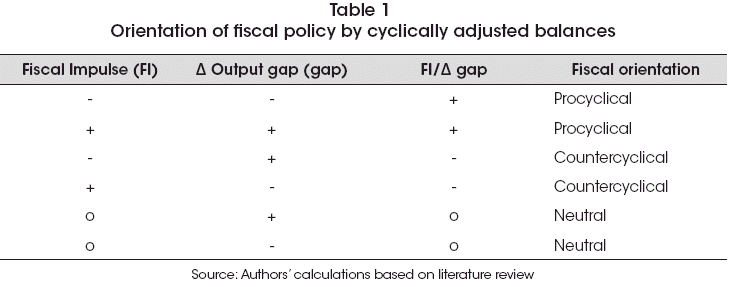
The output gap is defined as actual GDP less potential GDP divided by potential GDP. The fiscal impulse is the change in non-oil primary balance in cyclically adjusted terms.
It is noteworthy to show the limitations of the cyclically adjusted balance methodology focus on the sensitivity of the estimates with respect to output gap and the equilibrium of natural gas prices, therefore, deviations around the equilibrium conditions of medium and long term are the main methodological input and, at the same time, the core disadvantages (Girouard and Andre, 2006)
c) Evaluation of the Indicator of Fiscal Sustainability (IFS)
Finally in this section one target ratio of primary balance is evaluated based on Indicator Fiscal Sustainability (IFS) proposed by Croce and Hugo (2003), taking the following aspects:
Where:
![]()
In (10), b* and β* are formed, respectively in the primary balance and the discount fact that converges to the debt rule (d*) (Minimum value of public debt to real GDP over the period observed).
For computation of β*, it was considered the real interest rate on public debt (rt) (See Annex 3) and the rate of real output growth (gt):

Where βt measures the spread between the real interest rate and the real growth rate observed in period t.
Based on the distribution of βt, two alternative discount factors were considered (β*); i) a baseline scenario that is the simple average of observed distribution of βt: ii) a scenario of greater volatility that corresponds to the maximum value of βt over the period covered.4 The aim of these scenarios is to offer two types of fiscal rules according to different contexts of economic activity.
Another factor of evaluation is λt, that corresponds to reaction of primary balance (bt) to primary balance target (b*); in the same way, public debt in the previous period (dt-1) is related to debt concerning target (d*):

The fiscal stance is sustainable when the difference between βt & λt is less than the threshold of 1:

4. Results
a) Formal institutional change and informal factors (post-nationalization)
According to Table 2, the nationalization of hydrocarbon led to increase a positive and significantly relation between capital and current spending in terms of oil and non-oil revenue. Moreover, the main change indicated a negative and significantly association between administration of oil fiscal revenues and primary balance -with and without oil.
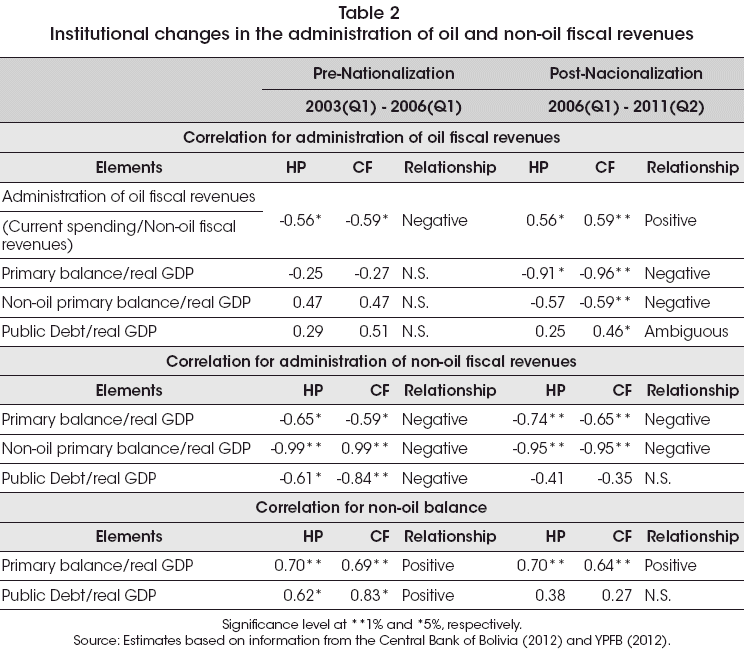
Finally prior to the nationalization of hydrocarbons, there was a strong link between the non-oil primary balance and public debt; during the post-nationalization, this relationship has weakened interpreted like a substitution in financing current spending: public debt was replaced with oil revenues.
No evidence was found for the first condition on fiscal role efficiency that established no deterioration in non-oil primary balance by the administration of oil and non-oil fiscal revenues. The deterioration of non-oil primary balance was due to a positive association between administration of oil and non-oil revenue (informal institutional changes) derived since the nationalization of hydrocarbons (formal change). On the other hand, the administration of government debt showed a countercyclical behavior related to output gap and the natural gas prices when correlating the cyclical components of the series (positive aspect).6
b) Cyclically adjusted fiscal balance (structural)
Elasticities of fiscal revenues
Elasticities were estimated for fiscal revenues by adjusting every selected component to fluctuations of natural gas prices and economic activity (Table 3).
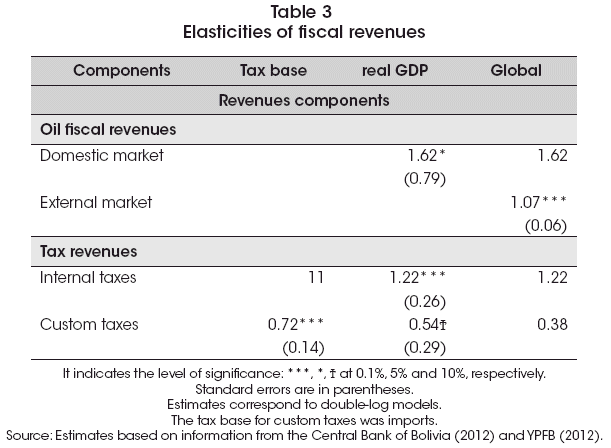
Elasticity of oil domestic market was very sensitive to real GDP. These findings were consistent with the estimates for developing economies such as Lozano and Toro (2007); therefore, domestic sales of natural gas and internal taxes were sensitive to changes in economic activity
Additionally the elasticity between oil external revenues and export prices was close to unity which agrees with Marcel (2003) and it is often taken as assumptions in other studies (Zambrano and Aguilera, 2010). Consequently there is an automatic stabilizer in oil fiscal revenues derived from external price movements.
In the case of custom taxes, this elasticity was inelastic with respect to its own base and related to real GDP, this finding may limit the participation of cyclical custom taxes on cyclically adjusted balance.
Discretionary of fiscal policy
While rise of natural gas prices (2004-2008), the fiscal policy of Bolivia was expansionary, during the global economic slowdown (2009) the role was neutral (Figure 1).
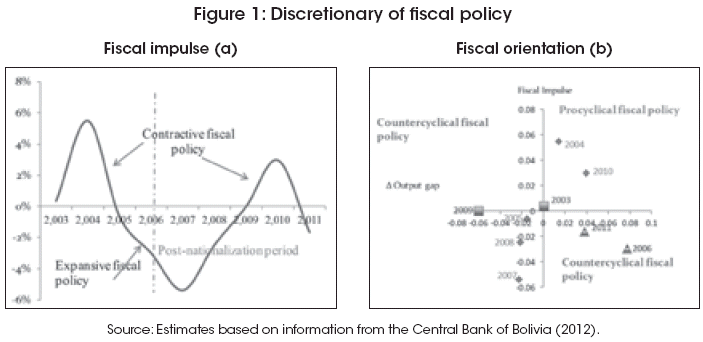
During the period 2007-2009 (post-nationalization), it was shown the most procyclicality of fiscal policy: the ratio fiscal impulse (FI)/gap variation was close to 1. For the period 2010-2011, there was a less procyclical with tendency to neutrality orientation (the coefficient was close to zero).

Overall balance versus cyclically adjusted fiscal balance
According to Figure 2, it can be seen that before nationalization (2003-2005) there was no difference between the overall balance (observed) and the cyclically adjusted balance, suggesting two things: i) activity of natural gas generated less dependence on the fiscal stance, ii) economic activity and external prices were very close to its equilibrium and long-term levels.
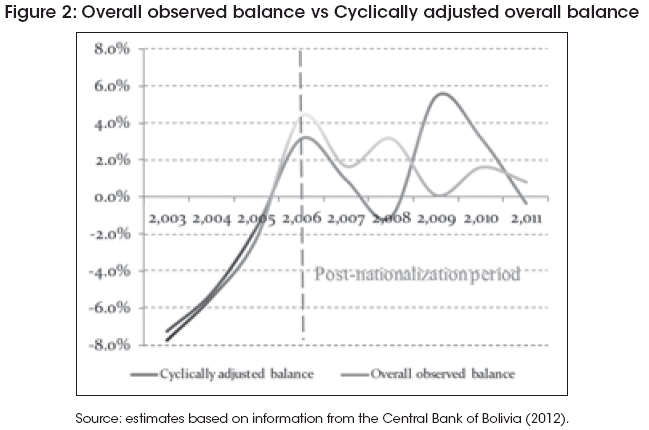
The difference between the cyclically adjusted balance and observed balance is explained by three phases: i) favorable external context (2006-2008), economic activity and natural gas prices were above its equilibrium level, therefore, observed balances were greater than cyclically adjusted balances; ii) global recession (2009), even for 2010, natural gas prices and economic activity showed results below potential level: cyclically adjusted balance was greater than the observed balance; iii) a period for economic recuperation (2011) that reflects higher observed balance related to cyclical balance. The cyclically adjusted balance results for Bolivia, during the period 2005-2009, were consistent with the findings of Zambrano and Aguilera (2010).
Consistent with previous results, the decomposition of cyclical adjusted balances (Figure 3) showed that -before nationalization- the overall fiscal balance was basically composed by structural component. During the post-nationalization period, there was a positive impact of cyclical economic and external prices for the period 2006-2008, and a negative effect for 2009 (in some extent for 2010).
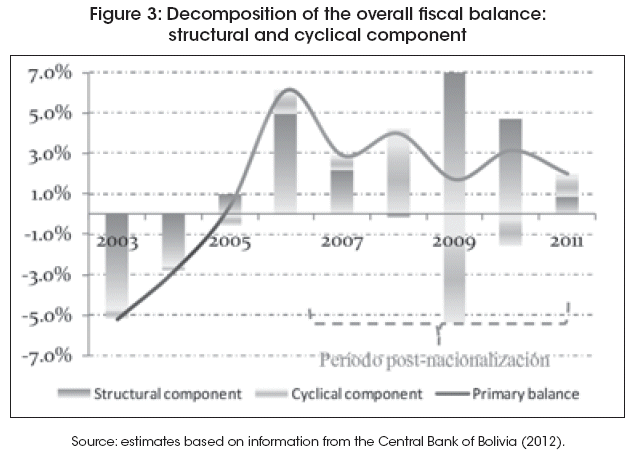
Transition of the cyclical components of the overall fiscal balance
Finally, it was considered the cyclical transition of overall balance components (Figure 4), where there were three important moments: i) a substantive decrease in the internal dependency of economic activity represented by internal taxes (decreased from 98 to about 20% of cyclical movements); ii) oil dependence begins with a greater participation from domestic gas market, especially for 2007 (50% of the cyclical movements); iii) consolidation of oil dependency to external markets (the strongest share was in 2008 over 80%).
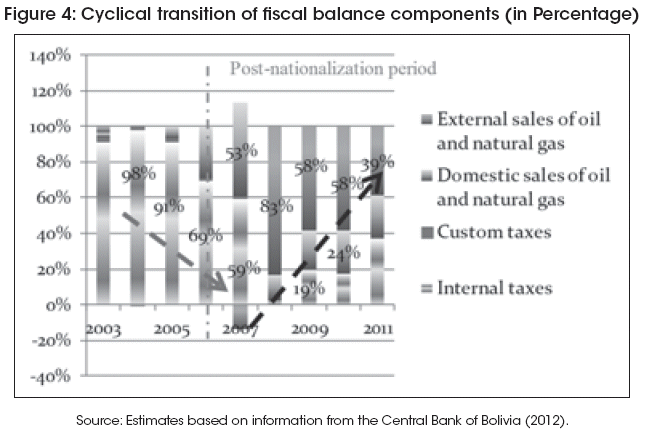
The above findings suggest a deficient fiscal role based on progressive participation of natural gas sales (domestic and external gas market) by the cyclical component of overall fiscal balance.
a) Evaluation of sustainable fiscal position (PFS) for Bolivia
In the previous section, it was evaluated the orientation of fiscal policy related to economic activity and natural gas prices, as well as the mechanism of cyclical transition changes in the overall fiscal balance. In this section, the purpose was to evaluate if the fiscal stance, measured by the primary balance (with and without oil), was sustainable based on the algorithm proposed by Croce and Hugo (2003).
By two alternatives proposed, primary balances were estimated with two goals: a baseline scenario and in context of higher volatility and internal and external economic uncertainty (volatile scenario). Consequently volatile scenario demanded a higher primary balance target compared with baseline context, therefore, the alternative of uncertainty is more prudent and cautious (Table 5).

The fiscal stance of Bolivia was sustainable for the baseline scenario and inconclusive for a volatile scenario (weak sustainability). However, when it was evaluated non-oil primary balance, it reflected an unsustainable fiscal stance for both contexts (Table 6).

Last results can be evaluated in dynamic context by considering each year of study The basic evaluation criteria establish not to cross the threshold of 1 in relation to attain sustainability In Figure 5, it has shown that primary balance improved after nationalization.
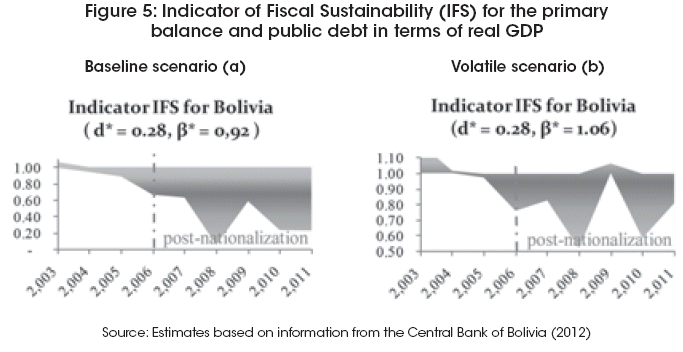
Conversely when considering non-oil primary balance, the fiscal stance was unsustainable (Figure 6).
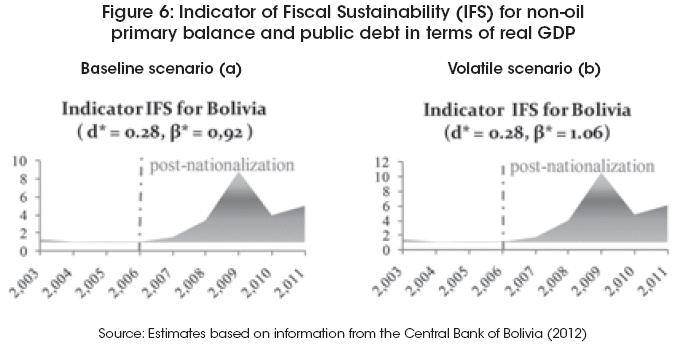
In sum, the fiscal stance of Bolivia, from 2003 to 2011, was unsustainable in an exponentially way, with more emphasis on post-nationalization period, the core argument sustains that non-oil primary balance is the main fiscal indicator for oil dependent economies (gas natural).
5. Discussion
Institutions can be perceived and interpreted in endogenous way instead of causation effect, but this constitutes a liability for some econometricians based on the argument of modeling by exogenous variables (Frankel, 2010:15).
In this article, the results showed that one formal institutional change led to new mechanisms for administration of oil and non-oil fiscal revenues. In the absence of fiscal rules, the new guidelines of government -in unregulated oil revenue administration- can get unwanted results. According to the new institutional economics, institutions are more efficient if governments improve selected results given the economic organization of the state. Applying the above definition to the fiscal stance, in the case of Bolivia, the management of public debt was adequate, consistent with the argument that a good fiscal role is to reduce the public debt during boom periods (Smidova, 2011). The rationale for maintaining low levels of public debt to GDP is centered on the possibility of greater scope for fiscal policy when there is any economic downturn (Mates, 2011).
Regardless of the good direction of public debt, non-oil primary balance was unsustainable; the above findings coincided with Zambrano and Aguilera (2010) with respect to the fiscal sustainability of Bolivia. The progressive non-oil deficit can lead to severe structural adjustments in fiscal policy, and therefore it could affect negatively the macroeconomic prospective if this behavior is not reversed. Hart (2009) defined as irresponsible management of fiscal deficits when they are not attributed to the economic circumstances.
Prior to the nationalization of hydrocarbons and oil industry there was an inverse relationship between the administration of oil and non-oil fiscal revenues (there was an adjustment between capital and current spending). For post-nationalization period, the relationship consisted in increase capital and current expenditure at the same time. Thus, the unsustainability of non-oil primary balance was not due to nationalization (formal institutional change) but in administration of oil and non-oil fiscal revenues (informal institutional changes).
Main findings revealed procyclical movements to economic activity by applying cyclically adjusted fiscal balance methodology These results are consistent with evidence that developing countries have procyclical policies (Strawczynski and Zeira, 2011; Daude Melguizo and Neut, 2010; Ilzetzki and Végh, 2008), especially for countries that depend on commodity prices (Kaminsky 2009). According to the Keynesian stance, it would have expected in a countercyclical role. The neoclassical approach suggested a neutral stance, however, when the degree of substitution between public investment and private investment is strong, the fiscal stance should be countercyclical (Hathroubi and Rezgui, 2011). In general, there was no evidence for any positions mentioned before.
The existence of informal rules on the discretion of the administration of oil and non-oil revenues leads to a deterioration in non-oil primary balance. Why do not governments implement restrictions on limiting public spending? Why not specific discretion over the administration of oil and non-oil fiscal revenues? The answer is related to maximization of their own interests (Cabrales and Hauk, 2011), resulting in inefficient institutions. From the perspective of agents and principals, the government acts as an agent to self opportunistic discretionary fiscal policy Consequently society (principal) has no control over the handling of oil resources.
Implications for policy
The absence of formal fiscal rules leads to high transaction costs related to the economic organization of the state, in this case, as oil and non-oil fiscal revenues are managed. In the case of Bolivia, the management of public debt (countercyclical) was properly conducted; however, there was evidence of unsustainable non-oil primary balance.
According to the indicator of fiscal sustainability (IFS), under the assumption of a volatile scenario -on the real interest rate and output growth- the primary balance limit was determined around 1.7% of real GDP, but it is also necessary to include classical escape clauses (for periods of contraction or slowdown). The generation of this surplus would converge to the minimization of public debt around the recent past, considering that already showed a period of global economic slowdown.
Additionally there is a need to impose restrictions in the administration of non-oil fiscal revenue: current spending must limit to non-oil fiscal revenues; additionally it is necessary to establish specific regulatory purposes in the administration of oil fiscal revenues: l) investment public, 2) direct transfers to society 3) amortization of debt, 4) public savings. The fiscal rule based on limiting the public spending provides a better control of public resources because it is independent of any economic projection (Schick, 2010), while the imposition and enforcement of fiscal rules constitutes an additional fiscal role (Musgrave, 1997).
The establishment of specific destinations for oil revenues allows for greater transparency of fiscal institutions, and in that way it is easy to control the performance of government (Dzialo, 2012). The proposed mechanisms will allow to obtain a sustainable fiscal stance in terms of primary balance (with and without oil) and public debt. Additionally, the establishment of rules related to public savings will mitigate the progressive involvement of fluctuations in natural gas prices in the cyclically adjusted balance.
As consequence, the final solution focuses on the application of formal institutional rules that lead to public budget by formulation with and without oil considerations; in other words: convert informal to formal institutional changes.
Limitations and research agenda
In this paper, it was evaluated efficiency elements related to the fiscal role, but did not assess causality Future research can be designed around the impact of institutional changes (from administration of oil and non-oil revenues) and the orientation of fiscal policy based on the level of fiscal sustainability. It also is mentioned that the reaction of fiscal policy can be in a non-linear way (Égert, 2010), aspect that was not addressed in this document.
The indicator of fiscal sustainability (IFS) proposed by Croce and Hugo (2003) cannot capture the fiscal reaction derived from price shocks of a natural resource and how oil revenues are managed. Therefore, it is necessary to specify a methodology that enables to measure the responses of fiscal stance and its degrees of sustainability cases: a) strong, b) weak (inconclusive) and c) unsustainable.
6. Conclusions
The purpose of this article was to evaluate the efficiency of fiscal role from the nationalization of hydrocarbons (formal institutional change) and administration of oil and non-oil fiscal revenues (informal institutional changes) in the case of Bolivia. To evaluate this efficiency was considered the new institutional economics perspective, considering the cost of economic organization as the mechanism of oil revenue management and in relation to capital and current spending. The final product of efficiency was the fiscal stance measured by primary balance (with and without oil) and public debt.
The result was a poor fiscal role as oil and non-oil revenue administration were associated negatively with non-oil primary balance, although public debt was addressed in a countercyclical manner. This deficiency in fiscal role was based on four main points.
First, there was deterioration in non-oil primary balance based on a positive relationship between the administration of oil and non-oil fiscal revenues: increased in capital and current spending.
A second factor of deficiency was the procyclical orientation of fiscal policy to economic activity and natural gas prices by employing cyclically adjusted balance methodology. Two theoretical perspectives suggest different fiscal orientations: countercyclical policy during recessions (Keynesian stance) and neutral policy in each period of analysis (neoclassical stance).
The third element of fiscal deficiency was associated with a progressive increase in the participation of cyclical fluctuations derived from natural gas prices on the overall balance cyclically adjusted. The cyclical transition meant less dependence from domestic economy (internal taxes) towards a greater relative contribution from external markets of natural gas.
The fourth factor was based on unsustainability of non-oil primary balance from nationalization of hydrocarbons. By contrary a non-progressive deterioration of non-oil primary balance has indicated a conclusive element of sustainable fiscal stance.
The suggestions for policies were made on how fiscal revenues should be administered by establishments of formal fiscal rules for budget formulation in order to achieve a sustainable fiscal stance.
Fecha de recepción: 27 de febrero de 2015
Manejado por: ABCE
Fecha de aceptación: 30 de abril de 2015
Notes
* Universidad Autónoma del Estado de México. Contacto: aleconomista@gmail.co
** Universidad Autónoma del Estado de México. Contacto: reyna_vg@yahoo.com
1 This period is considered due to following reasons: 1) from 2003 the boom in commodities prices begins, even though this trend could be appreciated since 1999, the change in slope with greater intensity appeared from this period, 2) after mid-90's many oil producing countries took time to stabilize their public finances. By 2003, most countries were able to respond to price shooks (Villafuerte and Lopez, 2010, p. 4).
2 It uses this period to avoid the problem of endpoint for the Hodrick and Prescott. Indeed series were used from 2000 until 2012 to obtain the cyclical components.
3 For the Bolivian case, it was assumed that Other Non-Tax revenue and Mining royalties were not affected by the economic cycle.
4 Croce and Hugo (2003:8) indicated that the expected value of β* should constitute about 1 for mature economies; greater than 1 for economies with capital scarcity and high costs of financial intermediation; finally, much greater than 1 under contexts of economic volatility and political uncertainty. Additionally, it is presented the case of β* <1, when the real interest rate is lower than the actual growth rate.
5 In the theoretical framework, there are mentioned three degrees of fiscal sustainability: a) strong grade, if the condition was observed more than 75% of the period, b) unsustainable grade, abiding by less than 25% of the period covered o) weak grade (inconclusive), if the rank was between 25 and 75% of the period.
6 The correlation was negative and significant between the cyclical components of government debt in relation to GDP and natural gas prices: -0.49 (Hodrick and Prescott-HP) and -0.54 (Christiano and Fitzgerald-CF) during the period: 2006 (Q2) - 2011 (Q2). Similarly, it was found a negative correlation between public debt and GDP the output gap:-0.35 (HP) and -0.48 (CF). In all cases, significance was below 5%.
References
1. Bachev, H. (2010). Efficiency and Sustainability of Economic Organizations in Agri-business. Institute of Agricultural Economics Sofia, Bulgaria, October, 4 (1), 5-22.
2. Banco Central de Bolivia, B. (2012). Información estadística del sector fiscal y la deuda pública. Banco Central de Bolivia, Asesoría Principal de Política Económica. Información estadística proporcionada.
3. Cabrales, A. & Hauk, E. (2011). "The quality of political institutions and the curse of natural resources". The Economic Journal. March, 58-88.
4. Christiano, L., & Fitzgerald, T. (2003). "The band-pass filter". International Economic Review, 44 (2), 435-465. [ Links ]
5. Croce, E., & Hugo J. (2003)."Assessing Fiscal Sustainability: A Cross-Country Comparison". International Monetary Fund Institute. [ Links ]
6. Dabla-Norris, E.; Allen, R.; Zanna, L.; Prakash, T; Kvintradze, E.; Lledo, V; Yackoviev, I. and Gollwitzer, S. (2010). "Budget Institutions and Fiscal Performance in Low-Income Countries". International Monetary Fund, WP/10/80, IMF Working Paper.
7. Daude, C, Melguizo, A. &Neut, A. (2010). Fiscal Policy in Latin America: Countercyclical and Sustainable at last?. OECD Development Centre, Working Paper, N° 291.
8. Devarajan, S., Minh Le, T. & Raballand, G. (2010). "Increasing Public Expenditure Efficiency in Oil-rich Economies". Policy Research Working Paper 5287, The World Bank, África Región, Chief Economist Office, April. [ Links ]
9. Dhumale,R. (2000)."Public Investment in the Middle East and North Africa: Towards Fiscal Efficiency". Development Policy Review, 18,307-324. [ Links ]
10. Dzialo, J. (2012). "Fiscal Rule and Effective Fiscal Policy". Comparative Economic Research 15(2), 65-78. [ Links ]
11. Égert, B. (2010). "Fiscal Policy Reaction to the cycle in the OECD: Pro- or Counter-cyclical?". OECD, Economic Department Working Paper N° 763.
12. Frankel, J. (2010). "The Natural Resource Curse: A Survey". NBER Working Paper Nº 15836,1-55.
13. --------- (2011). "How Can Commodity Exporters Make Fiscal and Monetary Policy Less Procyclical?. Harvard Kennedy School, RWP11-015, Faculty Research Working Paper Series.
14. Girouard, N. & Andre, C. (2006). "Measuring Cyclically-Adjusted Budget Balances for OECD Countries". Organization for Economic Co-Operation and Development (OECD), Economies Department (ECO). [ Links ]
15. Guedes de Oliveira, E (2008). Empirical determinants of government efficiency CEGE. 28, February [ Links ]
16. Gurvich, E, Vakulenko, E. & Krivenko, P (2009). "Cyclicality of Fiscal Policy in Oil-Producing Countries". Problems of Economic Transition, 52 (1), 24-53. [ Links ]
17. Hart, N. (2009). "Discretionay Fiscal Policy and Budget Déficits: An Ortodox Critique of Current Policy Debate". The Economic and Labour Relations Review, 19 (2), 39-58. [ Links ]
18. Hathroubi, S. & Rezgui, S. (2011). "Fiscal Policy Cyclicality in Developing Countries: Case of Tunisia". Interdisciplinary Journal of Contemporary Research in Business, 3 (5), 41-66. [ Links ]
19. Haunner, D & Kyobe, A. (2008). "Determinants of government efficiency". IMF Working Paper 08/228. [ Links ]
20. Hodrick, R. & Prescott, E. (1997). "Post-war Business Cycles: An Empirical Investigation". Journal of Money Credit, and Banking, 29,1-16. [ Links ]
21. Ilzetzki, E. (2006). "Rent seeing distortions and procyclicality". Munich Personal RePEc Archive, Paper N°. 11900, posted 10.
22. Ilzetzki, E. & Végh, C. (2008). "Procyclical Fiscal Policy in Developing Countries: Truth or Fiction?". Manuscript University of Maryland and NBER. [ Links ]
23. INE. (2013). Instituto Nacional de Estadística. Retrieved: 15 de enero de 2013, de www.ine.gob.bo [ Links ]
24. Kaminsky, G. (2009). "Terms of Trade Shocks and Fiscal Cycles". En: C. A. Reserve Bank of Australia and the Centre for Applied Macroeconomic Analysis (CAMA) (Australian National University (ed.), Inflation in an Era of Relative Price Shocks. Sydney 17-18,August. [ Links ]
25. Kydland, F. & Prescott, E. (1990). "Business Cycles: Real Facts and Monetary Myth". Federal Reserve Bank of Minneapolis Quarterly Review, 14 (2), 3-18. [ Links ]
26. Lozano, I. & ToroJ. (2007). "Fiscal Policy Throughout the Cycle: The Colombian Experience". Borradores de Economía, N° 434.
27. Marcel, M. (2003). "Balance estructural: la base de la nueva política fiscal chilena". Presentación del Gobierno de Chile. Ministerio de Hacienda. 27 de enero de 2003, Santiago de Chile. [ Links ]
28. Mates, N. (2011). "Fiscal Policy: Lessons From the Global Crisis". Croatian Economic Survey 13(1), 5-56. [ Links ]
29. Medina, L. (2010). "The dynamic effects on commodity prices on fiscal performances in Latin America". IMF, Working Paper 10/192. [ Links ]
30. Musgrave, R. (1997). "Reconsidering the fiscal role of the government". The American Economic Review, 87 (2), 156-159. [ Links ]
31. Olson, M. (1969). "The Logic of Collective Actions: Public Goods and the Theory of Groups". Cambridge: Harvard University Press. [ Links ]
32. Ossowski, R., Villafuerte, M., Medas, P. & Thomas, T. (2008). Managing the Oil Revenue Boom: The Role of Fiscal Institutions". IMF occasionaly paper Nº 260.
33. Schick, A. (2010). "Post-Crisis Fiscal Rules: Stabilizing Public Finance while Responding to Economic Aftershocks". OECD Journal on Budgeting, 10(2), 35-51. [ Links ]
34. Scott, R., & Davis, G. (2007). "Organization of the environment". In: Organizations and Organizing. Rational, natural, and open system perspectives. Pearson-Prentice Hall: Upper Saddle River. [ Links ]
35. Smidova, Z. (2011)."Public spending efficiency in the Czech Republic: Fiscal Policy framework and the main spending areas of pensions and healthcare". OECD, Economic Department Working Paper N° 922.
36. Strawczynski, M. & Zeira,J. (2011). "Procyclicality of fiscal policy in emerging countries: The Cycle is the Trend". Banco Central de Chile, Working paper N° 624, May
37. Talvi, E. & Végh, C. (2005). "Tax base variability and procyclical fiscal policy in developing countries". Journal of Development Economics, 78,156-190. [ Links ]
38. van der Ploeg, F. & Poelhekke, S. (2008). "Volatility and the Natural Resource Curse". OxCarre Research Paper, Nº 2008-03,1-30.
39. Villafuerte, M. & Lopez, P (2010) "Fiscal Policy in Oil Producing Countries during the Recent Price Cycle", IMF, Working Paper 10/28,1-41. [ Links ]
40. Villafuerte, M., López, P & Ossowski, R. (2011). "Riding the Roller Coaster: Fiscal policies of non-non renewable resources exporters in Latin American and the Caribbean". Banco Central de Chile, Working paper N° 609.
41. Wijnbergen, S. & Budina, N. (2011). "Fiscal Sustainability Volatility and Oil Wealth: A Stochastic Analysis of Fiscal Spending Rules". Timbergen Institute Discussion Paper TI 2011-068/2. [ Links ]
42. Williamson, O. (l996). "The Mechanisms of Governance". Oxford University Press.
43. Yacimientos Petrolíferos Fiscales Bolivianos. (2012). "Estadísticas de mercados de exportación". Yacimientos Petrolíferos Fiscales Bolivianos., Gerencia Nacional de Planificación, Inversiones y Estudios. Información Estadística proporcionada.
44. Zambrano, O. & Aguilera, G. (2010). "Elementos de sostenibilidad fiscal en países ricos en hidrocarburos: el caso de Bolivia". BID, documento de trabajo BID N° IBD- WP - 286.
Annex 1: Description of variables and sources used
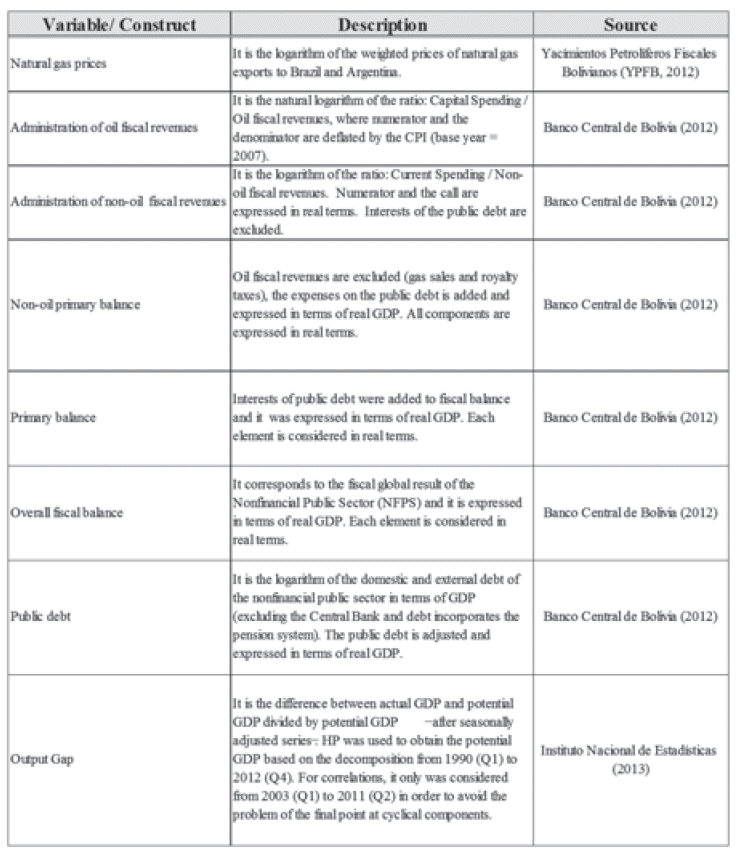
Hodrick-Prescott (HP)
The Hodrick and Prescott (1997) [HP] filter is a statistical method that decomposes the series in two components: long-term trend and irregular component. In applied macroeconomics, the first component is so often used to measure potential GDP (when the series analyzed is the GDP), the second component refers to cyclical fluctuations:
Observed Series = long-term term + cyclical fluctuations
![]()
The formal presentation of this decomposition is performed on the analysis of U.S. economic cycles (Hodrick and Prescott, 1997). The technical specifications are based on calculating the long-term trend {τt} of time series {yt} minimizing the variance of yt around τt subject to a penalty that constrains the second difference τt.
![]()
The penalty parameter {λ} softens the long-term trend: while this parameter is larger {λ → ∞} the long-term trend {τt} becomes more linear. Hodrick and Prescott (1997) used the penalty of 1600 for quarterly data.
Cristiano Filter and Fitzgerald (CF)
It was employed the filter developed by Christiano and Fitzgerald (2003) [CF] in its asymmetric sample or periodicities frequency bands (band-pass), under the assumption that series were non-stationary type. Unlike the symmetric version, this method does not require a specific number of lags that limit the application for series with small samples. CF filter allows the investigator to decompose the series in a number of irregular components that are mutually exclusive, and hence, the cycles are captured by periodicity bands.
Annex 3: Calculating the real interest rate for government debt
To find real interest rate on public debt weighted, the criterion above is followed by Croce and Hugo (2003):
It was considered the real interest rate on domestic debt (rtD) that included the average cost of domestic interest (itD) and the inflation rate (πt):

In the case of the real interest rate of external debt rtE, the following elements were considered: the average cost of external financing (it*), the exchange rate (et) and the inflation rate (πt):

Domestic borrowing was considered (dtD) and external debt (dtE), both expressed in terms of GDP, and then, it was calculated the total debt (dt). Finally, it was found the average of real interest rate on public debt (rt) based on the weighting of each funding source and its respective cost:















